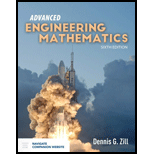
The solution of the given boundary value problem under given boundary conditions.
Answer to Problem 1CR
The solution of boundary value problem is
Explanation of Solution
Given:
The given boundary value problem is
Calculation:
The given boundary value problem is,
Take Fourier transform on both sides of the above equation,
Therefore, the equation is,
Apply Fourier cosine transform then the particular solution of the above equation is,
At the given boundary condition
Substitute the value of
At boundary condition,
Take Fourier transform of the above equation,
Partially differentiate the equation (3) with respect to
Equate the equations (4) and (5),
Substitute the value of
Take inverse Fourier transform of the above equation and apply Fourier cosine transform,
Thus, the solution of boundary value problem is
Want to see more full solutions like this?
Chapter 15 Solutions
Advanced Engineering Mathematics
- Problem 1. Let f(x, y, z) = ln(² | y² | 2²). a) What is the direction of maximal increase of f at the point (1, 1, 1)? b) At the point (1, 1, 1), how far in the direction found in (a) do you need. to go to obtain an increase of 0.1 in /? c) At the point (1, 1, 1), how far in the direction of (1, 1, 2) do you need. to go to obtain an increase of 0.2 in /?arrow_forward2. In this problem we prove that if Au(x, y) = 0 for all points in the x, y plane and u is a bounded function then u must be a constant. Hence if u is harmonic on the whole plane and non-constant then u must approach oo or -o along some direction. (1) Suppose u is bounded in the sense that Ju(x, y)| < M for all (x, y). Show that v(x, y) = u(x, y) + M is a harmonic function with v(x, y) 20 everywhere.arrow_forward8. Prove that f (z) =zz is nowhere analytic %3Darrow_forward
- 12. Show that F(x, y, z) = xy+ xz + yz has the value 1 if and only if at least two of the variables x, y, and z have the value 1.arrow_forward7. Integrate. Sad" √1-(x-1)² x+y x² + y² dydxarrow_forward3. a. Assume that P(x) and Q(x) are continuous over the interval [a, b]. Use the Fundamental Theorem of Calculus, Part 1, to show that any function y satisfying the equation | v(x)Q\x). dx + C v(x)y = for v(x) = eſ P(x) dx is a solution to the first-order linear equation dy + P(x) у 3D 0(х). dx b. If C = yov(xo) – J, v(t)Q(t) dt, then show that any solution y in part (a) satisfies the initial condition y(xo) = yo-arrow_forward
 Elements Of Modern AlgebraAlgebraISBN:9781285463230Author:Gilbert, Linda, JimmiePublisher:Cengage Learning,
Elements Of Modern AlgebraAlgebraISBN:9781285463230Author:Gilbert, Linda, JimmiePublisher:Cengage Learning,
